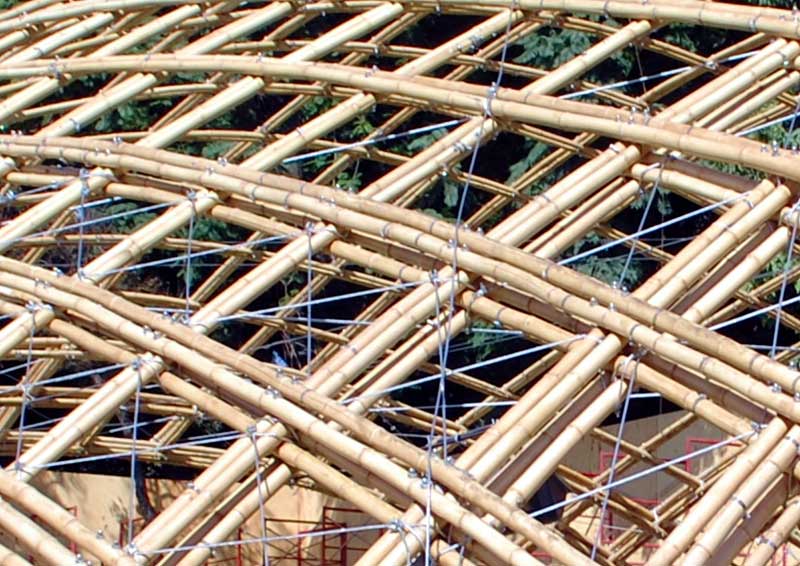Bamboo
Natural organic materials such as bamboo have a very important and unique role in the effort to alleviate housing and infrastructure problems, particularly in developing countries. Their use is of a special relevance in the context of widespread damage and destruction caused by natural disasters owing to global warming, which in part is attributed to the vast use of polluting and high-energy-demanding materials, such as steel and cement.
Although bamboo has been identified as the most promising building material for decades; technical, normative and cultural challenges have prevented its widespread use in construction.
However, after almost four decades of systematic research and development into bamboo, there is sufficient scientific information to increase the use of bamboo as a substitute for the industrial and polluting materials in many applications of the construction industry.
Bamboo grows in abundance in many parts of the world, especially in tropical and subtropical regions. Bamboo forests play an important role in controlling water cycles, reducing erosion and sequestering carbon from the atmosphere.
The culms of four to five years of age can be effectively used in construction and other engineering products. An increased use of bamboo does not pose a risk for bamboo forests; on the contrary, it will create economic incentives for farmers to develop bamboo plantations and use the bamboo shoots for their everyday lives.
An increase in the use of bamboo in construction could lead to energy savings, conservation of the world's scarce resources and reduction in environmental pollution. Bamboo forests are the most easily available resources for many communities, which can be used to solve housing problems. This is also a challenge to the science and skills of engineers accustomed to using well developed technologies.
Even though bamboo is a fast-growing, high-yielding and easily renewable natural resource, the ability of engineers to use it in durable construction requires more research and development.
The structural efficiency of bamboo compared to that of other engineering materials such as steel has been shown, which may be attributed to the high strength of the uniaxial reinforcing fibres and the hollow cylindrical shape of the culm. However, these characteristics along with the geometrical irregularities of the raw material pose challenges to develop efficient and cost-effective structural joints.
In addition, the major factors facing the development of durable bamboo constructions are the inherent weaknesses of the material, such as high water absorption and susceptibility to fungal and insect attack. Bamboo contains hemicelluloses, starch, sugar, tannins, certain phenols and lignin, which can be attacked by soluble extractives, preventing it from having a good durability characteristic.
Following years of research and development since the 1970s in South America, there is sufficient scientific information to increment the use of bamboo as a substitute for steel in many applications. Studies using timber test methods have shown that outdoor laminated bamboo has properties comparable to timber and glue-laminated timber.
This article was originally published here on 30 Mar 2017 by ICE. It was written by Khosrow Ghavami and José Jaime García.
--The Institution of Civil Engineers
[edit] Related articles on Designing Buildings Wiki
Featured articles and news
The UK's Modern Industrial Strategy: A 10 year plan
Previous consultation criticism, current key elements and general support with some persisting reservations.
Building Safety Regulator reforms
New roles, new staff and a new fast track service pave the way for a single construction regulator.
Architectural Technologist CPDs and Communications
CIAT CPD… and how you can do it!
Cooling centres and cool spaces
Managing extreme heat in cities by directing the public to places for heat stress relief and water sources.
Winter gardens: A brief history and warm variations
Extending the season with glass in different forms and terms.
Restoring Great Yarmouth's Winter Gardens
Transforming one of the least sustainable constructions imaginable.
Construction Skills Mission Board launch sector drive
Newly formed government and industry collaboration set strategy for recruiting an additional 100,000 construction workers a year.
New Architects Code comes into effect in September 2025
ARB Architects Code of Conduct and Practice available with ongoing consultation regarding guidance.
Welsh Skills Body (Medr) launches ambitious plan
The new skills body brings together funding and regulation of tertiary education and research for the devolved nation.
Paul Gandy FCIOB announced as next CIOB President
Former Tilbury Douglas CEO takes helm.
UK Infrastructure: A 10 Year Strategy. In brief with reactions
With the National Infrastructure and Service Transformation Authority (NISTA).
Ebenezer Howard: inventor of the garden city. Book review.
The Grenfell Tower fire, eight years on
A time to pause and reflect as Dubai tower block fire reported just before anniversary.
Airtightness Topic Guide BSRIA TG 27/2025
Explaining the basics of airtightness, what it is, why it's important, when it's required and how it's carried out.
Construction contract awards hit lowest point of 2025
Plummeting for second consecutive month, intensifying concerns for housing and infrastructure goals.
Understanding Mental Health in the Built Environment 2025
Examining the state of mental health in construction, shedding light on levels of stress, anxiety and depression.
The benefits of engaging with insulation manufacturers
When considering ground floor constructions.
Lighting Industry endorses Blueprint for Electrification
The Lighting Industry Association fully supports the ECA Blueprint as a timely, urgent call to action.

























